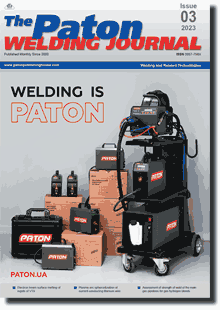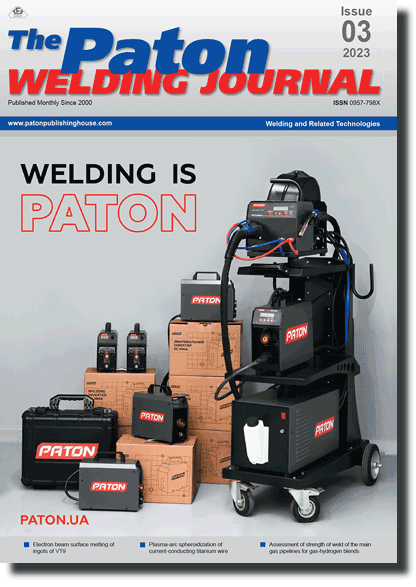| 2023 №03 (03) |
DOI of Article 10.37434/tpwj2023.03.04 |
2023 №03 (05) |

The Paton Welding Journal, 2023, #3, 26-32 pages
Features of the structure and physico-chemical properties of copper produced by the method of electron beam evaporation and condensation in vacuum
V.G. Hrechanyuk1, M.I. Hrechanyuk2, O.V. Khomenko2, I.M. Hrechanyuk1, V.I. Hots1
1Kyiv National University of Construction and Architecture of MESU. 31 Povitroflotskyi Prosp., 03037, Kyiv, Ukraine. E-mail: eltechnіc777@ukr.net2I.M.Frantsevych Institute of Materials Science Problems. 3 Omelyan Pritsak str., 03680, Kyiv, Ukraine.
Abstract
The structure and physico-chemical properties of copper, produced by the method of electron beam evaporation and condensation in vacuum were studied. A substrate from steel of St3 grade heated to 700 ± 15 °С was used for metal deposition. An intermediate pool from Cu–Zr–Y alloy was applied in the experiments. Evaluation of the properties of condensed copper, compared to cast one, showed a small difference in the values of specific electric resistance, and a certain increase of the level of mechanical characteristics, that is, probably, associated with the differences in its intragranular block structure. A 1.5 times increase of the condensate hardness was found in the case, when the intermediate pool was used, which is related to Zr and Y microalloying. Gravimetric studies of condensed copper corrosion in water revealed a significant influence on this process of such factors as presence of hardness salts in tap water and high specific electric resistance of distilled water. The greatest changes in the sample weight were observed in the first 10 hours of corrosion testing, and then process stabilization and monotonic decrease of sample weight took place. In tap water copper is characterized by the highest corrosion resistance, weight losses being two times higher under dynamic testing conditions than this value for static testing. Under dynamic conditions, the medium movement prevents salt deposition, and electric resistance increase becomes slower. Analysis of corrosion polarization diagrams confirmed the slowing down of corrosion processes in tap water, compared to distilled water. Results of measurement of surface electric resistance of the samples before and after testing showed that the initial corrosion period with a relatively fast weight change, is characterized by an abrupt increase of electric resistance of the sample surface, which points to a predominant formation of copper oxide (I); and reduction of the dynamics of electric resistance change in the next testing periods is due to stabilization of the processes of film growth with copper oxide formation (II). Ref. 17, Tabl. 4, Fig. 9.
Keywords: electron beam evaporation; vacuum; copper; condensates; mechanical characteristics; corrosion resistance
Received: 21.12.2022
Accepted: 24.04.2023
References
1. Pradyot, P. (2002) Inorganic compounds. Handbook of inorganic chemicals. https://fitk.iainambon.ac.id/tadrisipa/wp-content/uploads/sites/6/2020/10/handbook-of-inorganic-chmemical.pdf2. Hsu, Y.T., O'Reilly, B. (1977) Impurity effects in high-conductivity copper. J. of Minerals. Metals and Materials, 29, 21-24. https://doi.org/10.1007/BF03354339
3. Devis, J.R. (2001) Copper and copper alloys: ASM Specialty Handbook.
4. Chapman, D. (2011) High conductivity copper for electrical engineering. https://leonardo-energy.pl/wp-content/uploads/2019/03/mied%c5%b9-elektryka-raport.pdf
5. Movchan, B.A., Tikhonovsky, A.L., Kudinov, Yu.A. (1973) Electron beam melting and refining of metals and alloys. Kyiv, Naukova Dumka [in Russian].
6. Zolotoj, A.L. (1973) To problem of melting of copper and producing of ingots from it in electron beam furnace. Sb. Nauch. Trudov, 41, 45-53, Moscow, Giredmet [in Russian].
7. (2007) Electron beam melting in foundry. Ed. by S.V. Ladokhyn. Stal, Kyiv [in Russian].
8. Paton, B.E., Akhonin, S.V., Berezos, V.A. (2018) Development of technologies of electron beam melting of metals at the E.O. Paton Electric Welding Institute of the NASU.. Suchasna Elektrometalurgiya, 4, 19-35. https://doi.org/10.15407/sem2018.04.01
9. Grechanyuk, V.G., Grechanyuk, N.I., Chornovol, V.O. et al. (2022) Сopper and molybdenum-based nanocrystalline materials. Metallofizika i Noveishie Tekhnologii, 44(7), 927-942. https://doi.org/10.15407/mfint.44.07.0927
10. Bukhanovski, V.V., Minakova, R.V., Grechanyuk, I.N. et al. (2011) Effect of composition and heat treatment on the structure and properties of condensed composites of the Cu-W system. Metal Sci. and Heat Treatment, 53(1-2), 14-23. https://doi.org/10.1007/s11041-011-9334-x
11. Grechanyuk, N.I., Konoval, V.P., Grechanyuk, V.G. (2021) Properties of Cu-Mo materials produced by physical vapor deposition for electrical contacts. Powder Metallurgy and Metal Ceramics, 60(3-4), 183-190. https://doi.org/10.1007/s11106-021-00226-0
12. Grechanyuk, N.I., Grechanyuk, V.G. (2018) Precipitation-strengthened and microlayered bulk copper- and molybdenum-based nanocrystalline materials produced by highspeed electron-beam evaporation-condensation in vacuum: Structure and phase composition. Ibid., 56(11-12), 633-646. https://doi.org/10.1007/s11106-018-9938-4
13. Grechanyuk, N.I., Kucherenko, P.P., Melnik, A.G. et al. (2016) New electron beam equipment and technologies for producing of advanced materials using vacuum melting and evaporation methods developed at SPE «Eltechmaсh». The Paton Welding J., 5-6, 48-55. https://doi.org/10.15407/tpwj2016.06.08
14. Grechanyuk, N.I., Baglyuk, G.A., Kucherenko, P.P. et al. (2017) Laboratory electron-beam multipurpose installation L-2 for producing alloys, composites, coatings, and powders. Powder Metallurgy and Metal Ceramics, 56(1), 113-121. https://doi.org/10.1007/s11106-017-9878-4
15. Maissel, L., Glang, R. (1977) Handbook of thin film technology. 2nd Ed., McGraw-Hill, New York, USA.
16. Zhou, P., Kevin, O. (2018) The corrosion of copper and copper alloys. Ed. by K. Wandelt. Encyclopedia of Interfacial Chemistry: Surface Sci. and Electrochemistry, 6, 478-489. https://doi.org/10.1016/B978-0-12-409547-2.13429-8
17. Grechanyuk, V.G. (2006) Physical chemistry and chemistry of silicates. Kandor, Kyiv [in Ukrainian].
Suggested Citation
V.G. Hrechanyuk, M.I. Hrechanyuk, O.V. Khomenko, I.M. Hrechanyuk, V.I. Hots (2023) Features of the structure and physico-chemical properties of copper produced by the method of electron beam evaporation and condensation in vacuum. The Paton Welding J., 03, 26-32.The cost of subscription/purchase order journals or individual articles
| Journal/Currency | Annual Set | 1 issue printed |
1 issue |
one article |
| TPWJ/USD | 384 $ | 32 $ | 26 $ | 13 $ |
| TPWJ/EUR | 348 € | 29 € | 24 € | 12 € |
| TPWJ/UAH | 7200 UAH | 600 UAH | 600 UAH | 280 UAH |
| AS/UAH | 1800 UAH | 300 UAH | 300 UAH | 150 UAH |
| AS/USD | 192 $ | 32 $ | 26 $ | 13 $ |
| AS/EUR | 180 € | 30 € | 25 € | 12 € |
| SEM/UAH | 1200 UAH | 300 UAH | 300 UAH | 150 UAH |
| SEM/USD | 128 $ | 32 $ | 26 $ | 13 $ |
| SEM/EUR | 120 € | 30 € | 25 € | 12 € |
| TDNK/UAH | 1200 UAH | 300 UAH | 300 UAH | 150 UAH |
| TDNK/USD | 128 $ | 32 $ | 26 $ | 13 $ |
| TDNK/EUR | 120 € | 30 € | 25 € | 15 € |
AS = «Automatic Welding» - 6 issues per year;
TPWJ = «PATON WELDING JOURNAL» - 12 issues per year;
SEM = «Electrometallurgy Today» - 4 issues per year;
TDNK = «Technical Diagnostics and Non-Destructive Testing» - 4 issues per year.


